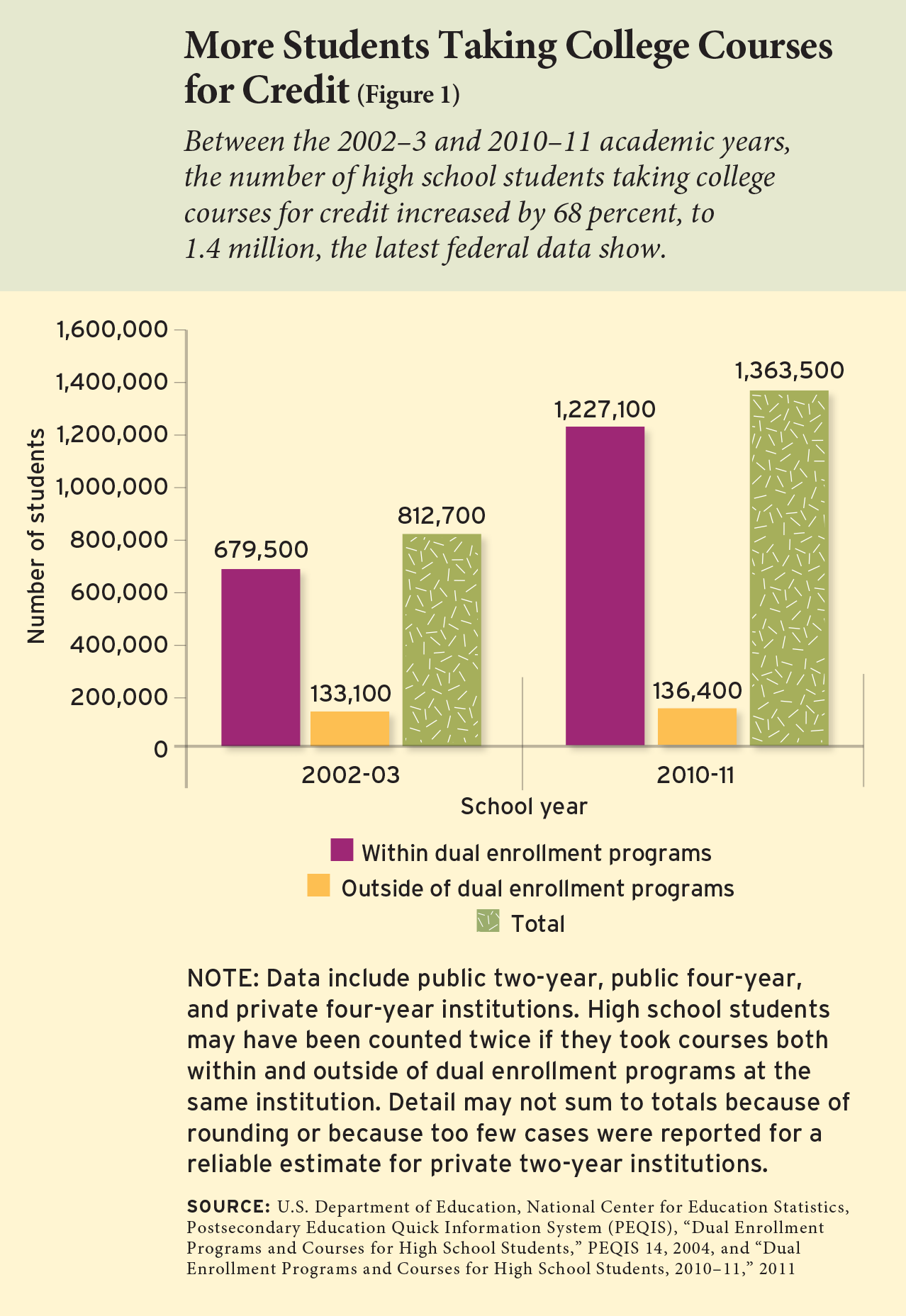
Aniken Castaneda took his first college course, art history, in the summer before his freshman year in high school. He liked the idea of being a college student, he said, and his parents told him it would give him a head start on a degree.
“It was kind of cool to be ahead of everybody,” he recalled.
And he didn’t stop there. By the time Castaneda graduated from Mercedes High School, in Mercedes, Texas, he had amassed 30 credits, enough to bypass of full a year of college. He hopes to complete his bachelor’s degree at Sam Houston State University in just two years.
“I’m taking as many classes as possible because its free and it’s something my parents won’t have to worry about and pay for,” he said.
Castaneda is part of a dual credit boom that is taking place in Texas and nationally, as states seek ways to get more students into and through college with less debt. The trend may be accelerated by the move to distance learning in response to the coronavirus pandemic, as taking an online college course instead of a high school course becomes as simple as just clicking to open a different hyperlink while sitting at the same home computer.
Between the 2002-3 and 2010-11 academic years, the number of high school students taking college courses for credit increased by 68 percent, to nearly 1.4 million, the latest federal data shows (see Figure 1). By 2015, nearly 70 percent of high schools offered dual enrollment, according to the Government Accountability Office.
 In Texas, the number of students participating in the program grew by 753 percent between the fall of 2000 and the fall of 2017.
In Texas, the number of students participating in the program grew by 753 percent between the fall of 2000 and the fall of 2017.
The explosion has been a boon for the nation’s community colleges, which have seen adult enrollments plummet since the end of the last recession. At some two-year colleges, high school students now make up half of enrollments, according to The American Association of Community Colleges.
The rise of dual credit has benefitted students, too. Research shows that students who take dual credit courses are more likely to enroll in and complete college than students who don’t—and to finish faster, too. A few studies have found disproportionate benefits for low-income students.
“When a student successfully completes a dual credit course, their mindset changes,” said Michael Villarreal, a professor at the University of Texas at San Antonio who has studied the impact of dual credit.“They see that they can do college level coursework—that they are college material.”
Christian Martinez, the valedictorian at Mercedes High School, said taking dual credit courses gave him the confidence that he could succeed in medical school.
“I don’t feel too anxious for college,” he said. “Once I knew I could commit myself to my studies, I knew I could do it in long run.”
Dual enrollment is creating some financial challenges for four-year colleges, which depend on large lecture-based introductory courses to subsidize more expensive upper-level offerings and to recruit students to majors. With more students knocking off core courses in high school, core 101 classes are shrinking, and humanities departments are losing money and majors. A Texas study found the most common dual enrollment courses taken from 2012 to 2015 were English 1301 (Composition I), English 1302 (Composition II), History 1302 (United States History II), Government 2305 (Federal Government), History 1301 (United States History I), Economics 2301 (Principles of Macroeconomics), and Math 1314 (College Algebra).
Meanwhile, doubts about rigor dog the field, with skeptics asking whether the courses—which are often taught in high schools, by high school instructors—are truly comparable to college classes. In Texas and elsewhere, instructors have complained that they’re being pressured to lower their standards to keep pass rates high, while professors have said students who took core courses in high school are struggling in upper-level classes.
Last year, the American Association of University Professors issued a position paper that warned that, when it comes to dual enrollment, “financial considerations stemming from decreased enrollment too often predominate over pedagogical concerns.”
“Dual credit courses are not the equivalent of traditional college courses,” said James Klein, a history professor at Del Mar College, a two-year institution in Corpus Christie, Texas, who helped draft the paper.
In addition, racial and socioeconomic gaps in access to and enrollment in dual-credit courses have led some school and campus leaders to question whether the programs may be inadvertently deepening a divide they were supposed to bridge, giving a head start to students who would have attended college without them.

What About Rigor?
Doubts about the rigor of dual credit courses have led some colleges to limit the number of courses that will transfer or to accept only those that were taught on college campuses, by college faculty.
At the heart of those doubts is disagreement about whether high school teachers are qualified to teach college-level courses and fears that they’re not holding students to the same standards as college faculty would.
Castaneda and Martinez, who have taken courses taught by high school teachers as well as those taught by college faculty, said their dual credit courses were more challenging than their regular high school classes.
“Everything was at a much faster pace,” said Martinez. “I had to stay mentally involved the whole time, while in my high school classes I could slack off and still get it.”
Martinez said the professors were stricter than the high school teachers, who knew students personally and would go easy on them when they struggled.
Rules governing instructor qualifications for dual credit vary by state and accreditor. In just under half the states, high school teachers are required to possess the same credentials as faculty at the partner college, according to an analysis by the Education Commission of the States; in another 19, they must have earned either a master’s degree or a certain number of graduate credits in the field in which they’re teaching.
Enforcement of the rules has been spotty, a recent crackdown by the Higher Learning Commission revealed.
The commission reminded institutions in 2015 that dual enrollment instructors had to have a master’s degree or 18 graduate-level credit hours in the subject they were teaching. That set off a scramble among colleges in the commission’s 19-state jurisdiction. Though a majority of teachers in those states possessed master’s degrees, many of their degrees were in education, not a specialty. Faced with the threat of widespread cancellations of classes, the commission issued a reprieve, giving programs seven years to come into compliance.
The north-central accreditor isn’t the only one raising red flags about dual credit, however. In 2018, the Southern Association of Colleges and Schools Commission on Colleges issued a policy statement reiterating its rules regarding dual credit courses. Steven Sheeley, its senior vice president, said the reminder was prompted by recent growth in the programs.
“The institution has to demonstrate that it has control over admissions, curriculum, and faculty, so it doesn’t look like a second-class course,” he said.
Faculty associations, including the American Association of University Professors and the American Historical Association, have also registered their concerns The AHA called on history departments to exert “greater oversight of curriculum and instruction” and “ensure a college-level course is being offered.”
James Grossman, the American Historical Association’s executive director, said that with dual enrollment courses, unlike in International Baccalaureate or Advanced Placement classes, “there is no common assessment” to make sure that what students are learning is comparable. “So you are really at the mercy of the oversight of the teacher and the teacher’s syllabus.”
In Texas, where more than 200,000 students participated in dual credit last fall, Raymund Paredes, the state’s former commissioner of higher education, has called for slowing the growth of dual enrollment, warning the state has “oversold the potential of dual credit courses.”
“The just there’s no way all those students could be college ready, or even close to college ready,” he said in an interview.
Harrison Keller, the current commissioner and a former top administrator at The University of Texas at Austin, shares those concerns. He worries that high school dual credit instructors may be tempted to water down their courses “because the high school grade is high-stakes for students” in the state.In Texas, the top 10 percent of each class is guaranteed admission to the state’s selective public colleges.
Keller, who replaced Paredes in 2019, said that while some districts are working to ensure that dual credit classes are as challenging as regular college courses, too many instructors still favor rote memorization over “a deeper engagement with the material.”
When he was still at UT’s flagship campus, Keller created a program that tackles that problem. Known as OnRamps, the program has faculty design courses and train their high-school counterparts to teach them, using inquiry- and project-based methods. To discourage grade inflation, students receive two grades—one from the high school teacher and one from the college professor.
The goal, he said, is “to help teachers and students understand what expectations look like on the higher ed side,” and to give students “the opportunity to recalibrate while the stakes are still low.”
Chester Finn, Jr., president emeritus of the Thomas B. Fordham Institute, said he’d like to see more programs like OnRamps, but acknowledged that such efforts are “expensive and laborious and not necessarily in the self-interest of a lot of institutions.”
“A lot of institutions that offer dual credit are doing it because they want enrollment—the butts in the seats and the state dollars” that come with them, he said.

Uneven Growth and Persistent Gaps
Dual enrollment is hardly a new concept. Colleges have been offering individual courses to high schoolers for decades, and the first state-wide program was created in the mid-1980’s, in Minnesota.
What has changed is the way it’s used.
Like Advanced Placement, dual enrollment started as a way to give more advanced students access to challenging coursework. It was seen as solution to senioritis and the wasted senior year.
But as the cost of college rose, and graduation gaps hardened, dual credit was repurposed. Policymakers began pitching the programs as a way to lower the cost of a degree and put more low-income and first-generation students on the path to postsecondary education.
Over time, states began offering the programs as early as freshman year. By 2010-11, forty percent of institutions allowed tenth graders to take their courses, and a quarter gave 9th graders that option, a federal survey found.
Some of that expansion took place in early-college high schools, which allow students to obtain both a high school diploma and an associate degree. Such schools multiplied after 2002, when the Gates Foundation began pouring millions into the early-college movement. Texas has dozens of them.
Yet in many parts of the country, dual credit still isn’t reaching many of the low-income, rural and minority students who need it most. Just over half of high-poverty schools—where a majority of the students are Black and Hispanic—offer dual enrollment courses, and only a quarter of small, high-poverty schools do, a study by the U.S. Government Accountability Office found. In districts that offer dual enrollment, Black and Hispanic students tend to participate at lower rates than their white and Asian peers, other research shows.
The growth of dual enrollment nationally has been uneven. Participation rates vary dramatically by state—ranging from barely one percent in Massachusetts to 23 percent in Indiana. Participation also varies by race, with 10.3 percent of white students taking dual credit, compared to 4.7 percent of Black students and 5.7 percent of Hispanic students, research by the Community College Research Center found.
In Texas, students of color make up a larger share of dual credit enrollments than they used to. In 2007, Hispanics accounted for 38 percent of enrollments and African Americans accounted for 5 percent; by 2017, those shares were 46 and 7 percent respectively, an increase “consistent with student enrollment of Texas public high schools,” according to the Texas Higher Education Coordinating Board.
Even so, just 10 percent of Black students and 16 percent of Hispanic students who graduated from Texas high schools in 2015 participated in dual credit in 11th or 12th grade, compared a 26 percent of white students, a study by the American Institutes for Research found.
Those gaps may be partly due to differences in the availability of courses. High-poverty schools, which disproportionately enroll students of color, may have a harder time attracting teachers with the credentials needed to teach dual credit courses than wealthier ones do.
But racial and socioeconomic gaps exist even in schools with robust dual credit programs. In fact, districts and metro areas with higher overall participation rates tend to have deeper racial and ethnic divides than those with lower ones, a study by the Community College Research Centerfound. This suggests that there are other variables at play.
One factor may be the programs’ eligibility criteria, which often include a minimum GPA or minimum score on a standardized test. While some states have opened up dual enrollment to average students, many still limit the classes to higher-achieving ones, according to the Education Commission of the States.
The cost of the classes may also be contributing to the gaps. Though most states offer the courses at a discounted rate—and a little over half make them free—students are often responsible for fees, textbooks and transportation costs, a report by the College in High School Alliance found.
A final factor could be educator bias. Schools often rely on the recommendations of counselors,seventy percent of whom are white, to identify students for dual enrollment. However unintentionally, their “judgments may be shaped by implicit (or even explicit) racial bias,” according to the Education Trust, a non-profit focused on equity in education.
Erik Gilbert, a history professor at Arkansas State University, said he’s seen a demographic shift in his classroom in recent years. Students enrolling in his introductory courses these days are more often minorities, adults, and graduates of rural high schools; the suburban, white, and middle-class students are going straight into upper-level ones.
Gilbert said he would like to do away with dual enrollment altogether, so students from across the social and economic spectrum can learn together. He said that general education used to be like the military draft—“it pulled people from all backgrounds together,” he said. “That’s not happening as much anymore as people go directly into majors.”
What the Research Shows
Studies in Texas and elsewhere have found that dual enrollment boosts key student outcomes, including high school graduation, college enrollment, college persistence and completion and time to degree.
Still, most of the evidence for dual credit has come from small-scale, single-state studies that haven’t controlled for selection bias: the possibility that students who choose the classes are more motivated, and more skilled, than those who don’t. In a 2017 literature review,
the Institute of Education Sciences found only two studies that met its standards for rigor, and both focused on early-college high schools.
In Texas, a pair of recent studies has ignited a debate over the benefits of dual credit. One, by the University of Texas system, found that dual credit students had higher GPAs than students who came in without college credits, and were three times as likely to graduate in four years.
The other, commissioned by the Texas Higher Education Coordinating Board, found that dual credit increased the odds of graduating for traditionally advantaged students only; for lower income students, it actually hurt their chances of completing college.
One surprising finding in the system’s study was that dual credit did not reduce borrowing for the majority of participants. While students surveyed by the researchers cited “saving time and money” as a major motivator for taking dual credit courses, only those who entered college with 60 or more credits— the number required for an associate’s degree—saw any significant reduction in student loan debt.
The Texas system’s report doesn’t speculate on why that is. But Angela Guadian-Mendez, director of student completion for the Alamo Colleges district, said she thinks it has something to do with colleges’ transfer policies.
Texas, like 28 other states, requires its public colleges to accept dual enrollment credit with no added restrictions.But in Texas, at least, colleges don’t have to count the credits toward the major. That means that many students must take additional classes—and incur additional debt—to graduate.
In an effort minimize this credit waste, the Alamo Colleges district recently created a “red-yellow-green” system that classifies dual credit students by their degree of focus. Students who aren’t sure what they want to study, or where they want to attend college, are limited to 9-18 credit hours of specific courses; those who have identified a pre-major or “career cluster” can take 21 to 45 credit hours, and those who have homed in on a both a college and pre-major can take 60-84.
“Now we have a system that can catch students and save them time and money,” says Guadian-Mendez.
So are dual credit courses a good investment for taxpayers, despite the credit loss? Research conducted in Texas and other states suggests they are.
For every dollar that Texas spent on dual credit instruction in 2016-2017, taxpayers are expected to gain $1.18 in reduced spending and increased tax revenue—the result of students taking less time to graduateand entering the workforce earlier—according to the coordinating board’s study, which was conducted by the American Institutes for Research. The long-term benefits of graduating more students, through increased tax revenue and reduced spending on social services, are projected to be almost double the cost.
Another AIR study that looked exclusively at early-college high schools found an even greater return on investment. Though such schools cost about $3,800 more per student, on average, than traditional high schools, their lifetime public benefit was about $23,973 per student, a cost-to-benefit ratio of roughly 6:1.
The Future of Dual Credit
Hoping to assure skeptical parents and policymakers of their quality, a growing number of programs are seeking recognition from the National Alliance of Concurrent Enrollment Partnerships, the field’s accreditor. Ten states now require or encourage NACEP accreditation, and ten have modeled their own standards after the accreditor’s.
To qualify for accreditation, programs must meet 16 standards showing that courses offered in high school are of the same quality and rigor as courses offered on campus; that dual-credit students are held to the same standards of achievement as regular college students; and that instructors meet the academic requirements for faculty, among other things.
Eligibility for accreditation is determined by teams of peer reviewers, who study documents submitted by applicants and interview program heads and instructors. In a departure from common practice in higher education accreditation, the reviewers don’t typically conduct site visits.
That will change this year, when reviewers will begin visiting all applicants, in an effort to conduct “a more thorough review,” said Jennie Patteson, the alliance’s director of accreditation.
“In this business, folks can make everything sound great on paper, but when you interact with them, you get a better idea of the picture,” she said.
Meanwhile, the dual credit enrollment boom shows no signs of slowing. Last year, state legislators considered at least 219 bills related to dual enrollment, according to the Education Commission of the States. Nearly half aimed to broaden access to the courses, either by lowering their cost or by removing barriers to student participation.
In Washington, the U.S. Education Department is running an experiment that is sending Pell grants to some students in dual credit programs. If Congress votes to open up the Pell program to dual credit students permanently, the courses will become affordable to many more students, and dual credit will grow exponentially.
The nationwide embrace of dual credit reflects a recognition on the part of policymakers that their economies will suffer if they don’t get low-income students and students of color to finish college. Many states have set ambitious postsecondary attainment goals, and they see dual enrollment as a key strategy to reach them, said Jennifer Zinth, a consultant who has written extensively on dual credit.
Dual credit will also remain a critical revenue stream for the nation’s community colleges, particularly as the number of high school graduates continues to decline nationally. In a 2016 survey by the Association of Collegiate Registrars and Admissions Officers, 60 percent of college leaders said they had adopted dual enrollment as a “strategic enrollment initiative,” and three-quarters said the programs were an important recruiting tool.
Still, the dual credit sector could face a few checks on its growth, including a shortage of qualified instructors. Though some districts have offered teachers financial incentives to get credentialed to teach dual credit, such efforts have yielded only incremental progress, according to a recent report by Jobs for the Future. “At the end of the day, it’s going to be hard to find enough teachers who fit the bill,” said Joel Vargas, a vice president at the organization.
For dual credit to continue to grow, and thrive, states and schools will need to find ways to train more teachers, advocates say.
They’ll also need to tackle the persistent racial, socioeconomic and geographic gaps that undermine the programs’ goals. Simply expanding the programs, without confronting the causes of those gaps, “could actually exacerbate them,” warned John Fink, a senior research associate at the Community College Research Center.
And they’ll need to come up with new ways to demonstrate the quality of their programs, as the debate over the rigor and quality of dual credit courses rages on, with no end in sight.
“I think we’ll always wrestle with it,” said David Troutman, a vice chancellor in the University of Texas system and the lead author of the system’s report. “I don’t think it will ever be put to rest.”
Kelly Field is a Boston-area freelancer who writes about equity and innovation in education.
This article appeared in the Winter 2021 issue of Education Next. Suggested citation format:
Field, K. (2021). The Rise of Dual Credit: More and more students take college classes while still in high school. That is boosting degree attainment but also raising doubts about rigor. Education Next, 21(1), 56-62.


